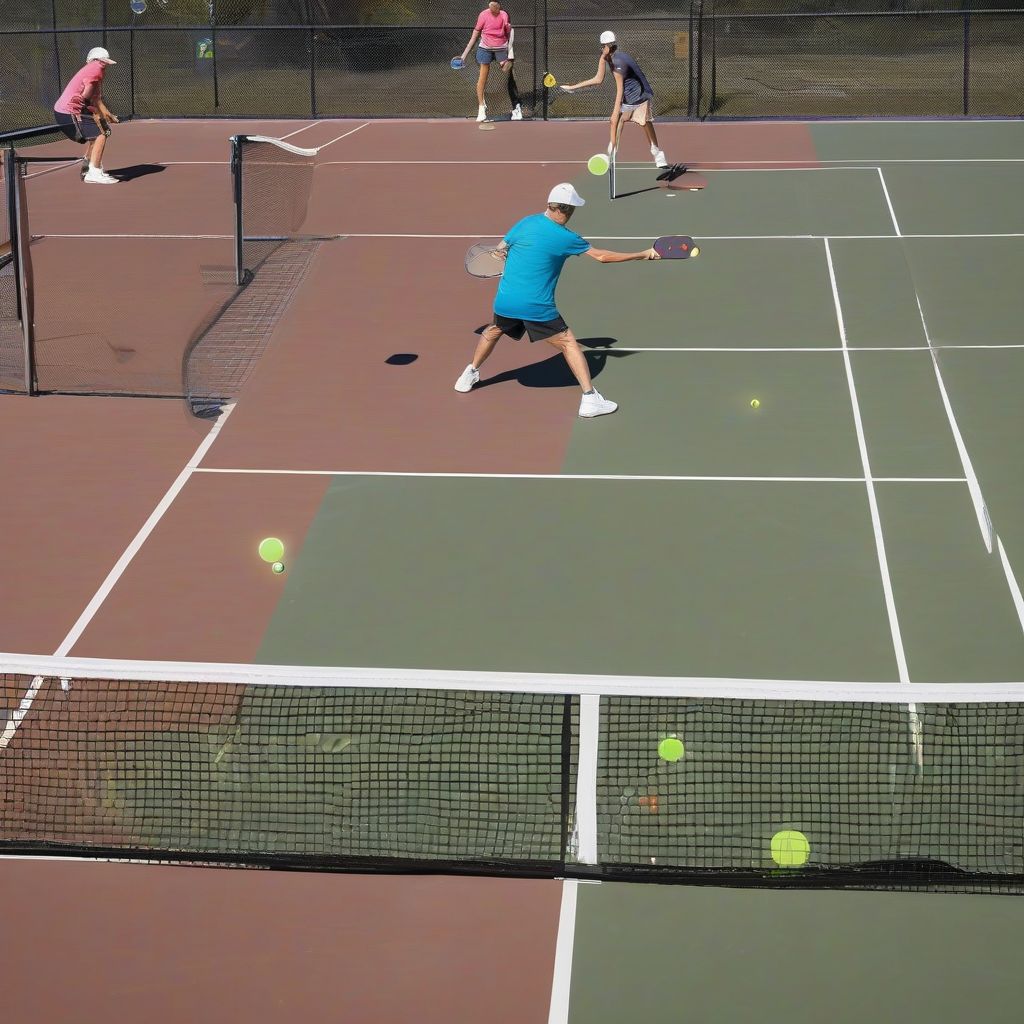Imagine this: You step onto the pickleball court, paddle in hand, heart pounding with anticipation. You’ve been practicing your serves, volleys, and dinks, but something feels off. You’re constantly scrambling to reach the ball, leaving gaps in your defense wider than a watermelon rind. What’s missing? The answer, my friend, lies in the often-overlooked art of pickleball positioning.
Pickleball, much like a well-choreographed dance, requires strategic movement and court awareness. It’s not just about hitting the ball hard; it’s about being in the right place at the right time, anticipating your opponent’s shots, and dictating the pace of the game. This, my friend, is where positioning becomes your secret weapon.
Why is Positioning So Crucial in Pickleball?
Think of the pickleball court as your culinary playground. Just as a master chef wouldn’t toss ingredients haphazardly into a pot, you wouldn’t want to be caught flat-footed on the court. Proper positioning allows you to:
- Reach More Balls: A well-positioned player can cover more ground, minimizing those lung-busting sprints and making even the toughest shots seem attainable.
- Control the Tempo: By dictating the pace and direction of play, you force your opponent to react to you, keeping them on their toes.
- Reduce Errors: When you’re in the right position, you have more time to set up for shots, resulting in fewer mishits and more controlled returns.
- Gain a Strategic Advantage: Positioning isn’t just about reacting; it’s about anticipating your opponent’s next move and positioning yourself to counter it.
The Fundamentals of Pickleball Positioning
Now that you understand the “why” let’s delve into the “how.” Here are the foundational principles of pickleball positioning:
1. The Non-Volley Zone (NVZ): Your Kitchen Command Center
The NVZ, affectionately dubbed “the kitchen,” is a 7-foot area on either side of the net. It’s the heart of pickleball combat, where volleys are forbidden and strategic dinking reigns supreme.
- Rule of Thumb: Avoid standing in the NVZ unless you’re volleying a ball that has bounced in this zone.
- Pro Tip: Position yourself just behind the NVZ line when your opponent is at the baseline, ready to pounce on any short shots.
2. Center Court: Your Home Base
Imagine the pickleball court as a clock face, with you facing the net. The 12 o’clock position, right in front of you, is your center court sweet spot.
- Why it Matters: Center court allows you to cover both sides of the court effectively, minimizing your opponent’s angles.
- Key Point: After each shot, strive to return to center court, ready to react to whatever comes your way.
3. Baseline Positioning: Covering Your Territory
When you’re forced to the back of the court, maintaining the right positioning is crucial to defend against those powerful drives.
- Footwork is Key: Stay light on your feet, ready to move laterally to cover the width of the court.
- Depth is Your Friend: Position yourself a few feet behind the baseline to give yourself time to react to deep shots.
Advanced Positioning Strategies: Taking Your Game Up a Notch
Once you’ve mastered the basics, it’s time to spice things up with some advanced positioning techniques:
1. Anticipation: The Art of Reading Your Opponent
Like a chess player thinking several moves ahead, you need to anticipate your opponent’s shots. Watch their body language, paddle position, and previous shots for clues.
- Example: If your opponent is leaning back and taking a big swing, chances are they’re going for a powerful drive.
2. Communication: The Doubles Duet
In doubles, communication is your secret weapon. Talk to your partner, call out shots, and move as a cohesive unit.
- Pro Tip: Use verbal cues like “yours” or “mine” to avoid confusion and collisions.
3. Poaching: The Artful Steal
In doubles, poaching involves intercepting a shot that’s technically your partner’s responsibility. It’s a risky but rewarding tactic.
- When to Poach: When you see an opportunity to put away a weak shot or catch your opponents off guard.
Putting It All Together: Positioning in Action
Let’s say you’re playing doubles, and your opponents hit a deep return. You and your partner should both move back to cover the baseline. As your opponents approach the net, adjust your position to guard the NVZ line. If one opponent hits a weak shot towards the middle, communicate with your partner and decide who will poach to put away the volley.
 Pickleball Positioning in Doubles
Pickleball Positioning in Doubles
Conclusion: Your Journey to Pickleball Positioning Prowess
Mastering pickleball positioning is an ongoing journey, but one that reaps immense rewards. By understanding the fundamentals, practicing diligently, and incorporating advanced strategies, you’ll transform from a court scrambler into a strategic mastermind, dictating play and dominating the game.
So, step onto that court with confidence, embrace the art of positioning, and watch as your pickleball game soars to new heights!
Now, tell me about your biggest positioning challenges on the pickleball court. What strategies have you found helpful? Share your thoughts in the comments below, and let’s keep the pickleball conversation flowing!
- Bond, Payton (Author)
- English (Publication Language)
- Baker, Joe (Author)
- English (Publication Language)
- Hall, Dennis (Author)
- English (Publication Language)
- Biff, Jaden (Author)
- English (Publication Language)
- Leach, Gale (Author)
- English (Publication Language)
- Callahan, John (Author)
- English (Publication Language)
- Carnot, Prem (Author)
- English (Publication Language)
- Moore, Daniel (Author)
- English (Publication Language)
- Jilson, Ben (Author)
- English (Publication Language)
- Hill, Cade (Author)
- English (Publication Language)








![Pickleball for Beginners: Level Up Your Game with 7 Secret Techniques to Outplay Friends and Ace the Court [III EDITION]](https://m.media-amazon.com/images/I/51la8IS6C4L._SL160_.jpg)

